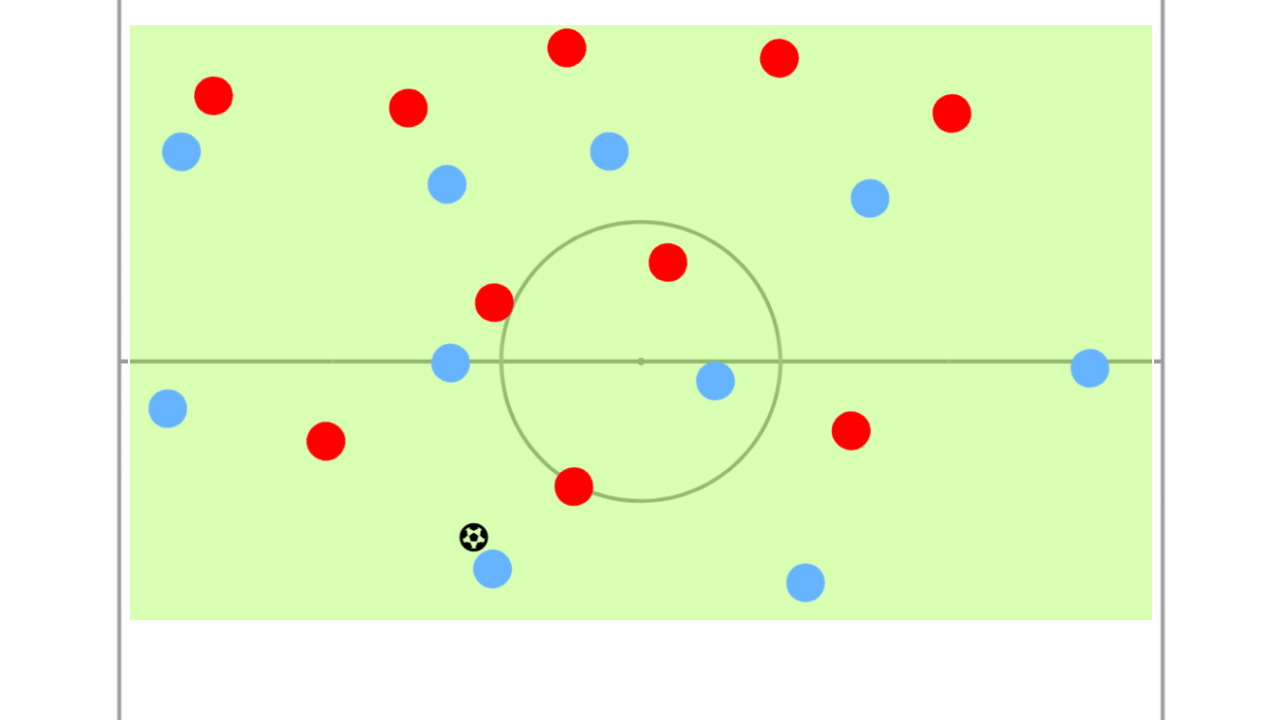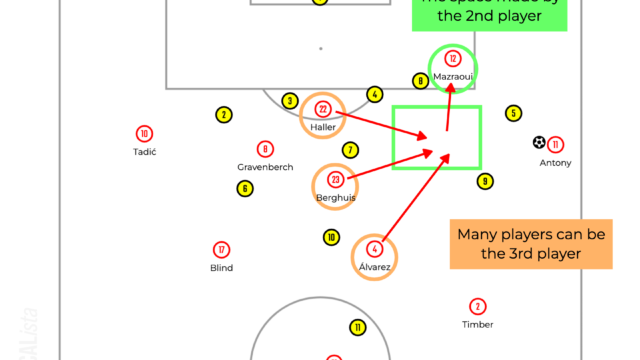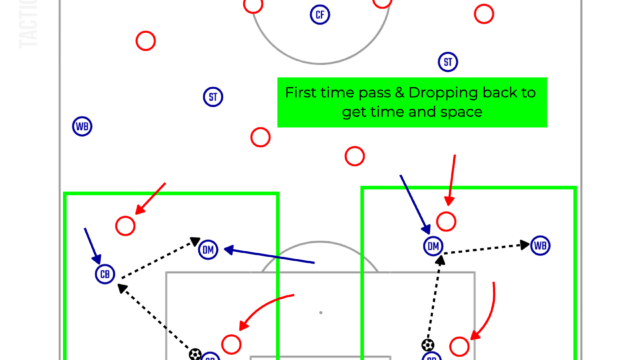Introduction
When analysing the game of football, the logic is extremely important. The logic means there is a reason or evidence for a certain situation. To identify this is the first step to know the principles or philosophy of the team. In general, reasons are various and some of them are attributed to tactics of a team or creative idea of a talented player. In many cases, however, those tactics or ideas can be attributed to the structure of the game.

Tactics of other teams or ideas of players cannot be perfectly understood unless they talk about them publicly, so this is one of the barriers when analysing games. However, the structure of the game never changed, so this can be stable evidence to analyse and explain a certain situation. For example, when pressing high in the opposition half, only showing the opposition outside is not enough because the team in possession can progress the ball by playing around. Moreover, when attacking in the final third, sticking to beat the opposition fullback in the wide area or playing towards one of the corner flags is not effective because the goal is in the middle. Like these examples, referencing the structure of the game is extremely important to analyse games and measure the effectiveness of what players are doing on the pitch.
In the game, it is possible to divide three situations depending on where the attacking team possesses the ball, so the characteristics of the game in each area are going to be discussed in detail in this article.
Own Half
As the main topic of this article is analysing the structure of the game as objectively as possible, the pitch geography, the rule of offside and the number of players, which never change unless players are sent off or FIFA changes rules, are going to be considered as important factors.

In terms of the pitch geography, the length of width never changes in each area while there is a limitation vertically. In the own half, it is possible to use the pitch forwards without any limitations, but the players cannot play back beyond the goal line behind them. This limitation cannot allow especially the centre backs and goalkeeper to play back. Thus, even when they are under pressure, they cannot play back to move the ball away from the pressure.
However, this does not mean the team out of possession can press more easily. The reason can be explained by understanding the rule of the game. The offside rule is not applied in the opposition half, so the back line of the defending team usually hesitates to push up beyond the halfway line. Therefore, when they try to press high and apply pressure on the opposition goalkeeper or centre backs, the whole shape is vertically stretched by around 50m (55 yards).
In this case, from the attacking point of view, it will be a tactical principle to find a spare player in between the lines. To prevent this, many teams try to press high with man marking to avoid allowing the attacking team to create and find a spare player. These tactical battles come from understanding the structure of the game.
The last factor is the number of players. Since it seems to be impossible to let the goalkeeper of the team out of possession move forward to mark one of the opposition attackers, it is an overload of a 11v10 for the team in possession. Additionally, the defending team prefers to secure an overload in the back line to prevent them from exploiting a 1v1 up front easily. Therefore, the team in possession is likely to have two spare players when playing out from the back.
As it was mentioned earlier, however, the defending teams often mark all outfield players to nullify this advantage. The reason why they can accept the risk of exposing the back line without a spare defender is that the long kick in behind from the goalkeeper or centre back is difficult for most players. Except for Ederson Moraes or Virgil van Dijk, kicking the ball from the deeper area of the own half to the behind of the opposition back line with high speed and accuracy is not a realistic option.
These tactical battles are based on the structure of the game, so it is possible to generalise and apply it to all football teams in the world.
Midfield
There are many differences in the midfield, so they are going to be compared based on the discussion in the previous chapter.

In terms of the pitch geography, there are no limitations anymore both horizontally and vertically. Therefore, unlike in the own half, the centre backs can play backwards to escape from the pressure. Therefore, it is possible to identify the skill of centre backs or principles in possession of teams to observe the behaviour of the centre back on the ball under tight pressure.
Additionally, thanks to the rule of offside, the back line of the defending team can be controlled by the defenders to keep the shape compact. This affects the space between the lines and in behind. Compared to the shape in the own half of the team in possession, the space between the lines becomes tighter while the available space in behind of the back line becomes bigger. In other words, for the team in possession, it becomes difficult to play through due to the tight space between the lines, but they can now have a realistic option to play over. In the own half, they need to kick the ball more than 50m, but only 30m long balls are enough to reach the space in behind in the midfield thanks to the compact defensive shape.
This means that if the team in possession can use the option of playing over, the opposition back line will drop deeper, increasing the space in between the lines. In other words, sticking to play short is not ideal and the ability to threaten the space in behind is extremely important. Again, the structure of the game influences the tactics so much.
Lastly, the number of players becomes a 10v10 as the goalkeeper of the team in possession hardly steps up to join the back line to keep the possession. Some teams try it, but they face the problem of vacating the own goal. Additionally, by moving the goalkeeper forwards, it becomes impossible to pass the ball backwards from centre backs to play away from the pressure because the goalkeeper will be pressed soon due to the high position.
Opposition Half
In the opposition half, they are required to score a goal, not just progress the ball forwards.

In the opposition half, in relation to the pitch geography, it is still possible to play back to move the ball away from the pressure, while it is not allowed to play forwards beyond the goal line in the opposition half. Therefore, it becomes difficult to play in behind when the opposition defenders drop deeply. Additionally, the specific difference here is that the direction of attacking. Since the goal is in the middle of the goal line, they need to play the ball towards the middle because it is the objective of the game. One of the particular actions in the opposition half is delivering a cross into the box from wide areas. This action is only selected there because the objective is scoring into the goal in the middle, not just progressing the ball forwards.
Moreover, the attacking players can take more risks to score a goal because they are far away from their own goal. On the other hand, the defenders cannot be as aggressive as they can in the midfield or opposition half because it leads set pieces that can produce many goals.
Additionally, since the attacking team tries to play the ball towards the middle, the defenders can choose to stay in the middle with accepting the opposition team to exploit the wide areas. No matter how good the attacking team can play in the wide areas, it does not matter for the defenders.
In terms of the rule of offside, the defenders can use it to keep the team compact. However, in the final third, the attacking team is influenced by the rule more. Like when the team out of possession presses high, the defenders hesitate to push the line beyond the halfway line when the opposition striker stays up front. This causes the division between the attackers and centre backs. To deal with this problem, it is required for the team in possession to keep the vertical balance to prevent the defending team from exploiting the gap between the attackers and defenders when playing a counterattack.
In this area, the number of players in the opposition half does not have a huge difference compared with the midfield. Since the goalkeeper of the defending team does not step up to mark someone, it is still a 10v10.
Conclusion
In this article, the structure of the game of football has been discussed. The analysis was based on the three areas and three factors to describe the characteristics as objectively as possible. The structure of the game can be a stable measure when analysing especially the unknown teams. I hope this article helps you to understand the game more interestingly. Thanks for reading.



